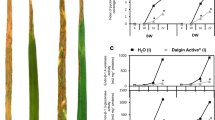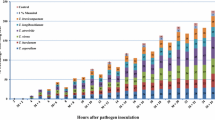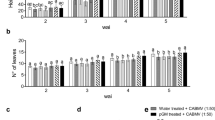Abstract
After a cell wall protein fraction (CWP) of Pythium oligandrum was sprayed on sugar beet leaves, we screened leaves for induced expression of defence-related genes and for resistance against Cercospora leaf spot. In a western blot analysis, the CWP was primarily retained on the surface of leaves without degradation for at least 48 h after spraying. In northern blot analyses, four defence-related genes (β-1, 3-glucanase, acidic class III chitinase, 5-enol-pyruvylshikimate-phosphate synthase and oxalate oxidase-like germin) were expressed more rapidly in CWP-treated leaves compared to control leaves treated with distilled water (DW). When CWP was applied to a suspension of cultured cells of sugar beet, an oxidative burst was observed that did not occur after the DW treatment. In growth chamber trials after inoculation with Cercospora beticola, the severity of Cercospora leaf spot was significantly reduced in CWP-treated plants compared to the DW-treated controls. In a field experiment, CWP treatment was also effective against the disease. CWP did not reduce growth rate of the pathogen in plate tests. The results together suggest that the CWP from P. oligandrum can be retained on the leaf surface and induce expression of disease resistance genes, thereby reducing Cercospora leaf spot on sugar beet.





Similar content being viewed by others
References
Abe H (1987) Studies on the ecology and control of Polymyxa betae Keskin, as a fungal vector of the causal virus (beet necrotic yellow vein virus) of rhizomania disease of sugar beet. Hokkaido Central Agricultural Experiment Station Report #60, Naganuma, Hokkaido, Japan
Al-Rawahi AK, Hancock JG (1998) Parasitism and biological control of Verticillium dahliae by Pythium oligandrum. Plant Dis 82:1100–1106
Benhamou N, Rey P, Chérif M, Hockenhull J, Tirilly Y (1997) Treatment with the mycoparasite Pythium oligandrum triggers induction of defense-related reactions in tomato roots when challenged with Fusarium oxysporum f. sp. radicis-lycopersici. Phytopathology 87:108–122
Benhamou N, Rey P, Picard K, Picard K, Tirilly Y (1999) Ultrastructural and cytochemical aspects of the interaction between the mycoparasite Pythium oligandrum and soilborne plant pathogens. Phytopathology 89:506–517
Benhamou N, Bélanger RR, Rey P, Tirilly Y (2001) Oligandrin, the elicitin-like protein produced by the mycoparasite Pythium oligandrum, induces systemic resistance to Fusarium crown and root rot in tomato plants. Plant Physiol Biochem 39:681–696
Davanlou M, Madsen AM, Madsen CH, Hockenhull J (1999) Parasitism of macroconidia, chlamydospores and hyphae of Fusarium culmorum by mycoparasitic Pythium species. Plant Pathol 48:352–359
Devergne J-C, Bonnet P, Panabières F, Blein J-P, Ricci P (1992) Migration of the fungal protein Cryptogein within tobacco plants. Plant Physiol 99:843–847
Garcia-Brugger A, Lamotte O, Vandelle E, Bourque S, Lecouriex D, Poinssot B, Wendehenne D, Pugin A (2006) Early signaling events induced by elicitors of plant defenses. Mol Plant-Microbe Interact 19:711–724
Gaulin E, Dramé N, Laffitte C, Torto-Alalibo T, Martinez Y, Ameline-Torregrosa C, Khatib M, Mazarguil H, Villalba-Mateos F, Kamoun S, Mazars C, Dumas B, Bottin A, Esquerré-Tugayé MT, Rickauer M (2006) Cellulose binding domains of a Phytophthora cell wall protein are novel pathogen-associated molecular patterns. Plant Cell 18:1766–1777
Gottschalk TE, Mikkelsen JD, Nielsen JE, Nielsen KK, Brunstedt J (1998) Immunolocalization and characterization of a β-1, 3-glucanase from sugar beet, deduction of its primary structure and nucleotide sequence by cDNA and genomic cloning. Plant Sci 132:153–167
Hase S, Shimizu A, Nakaho K, Takenaka S, Takahashi H (2006) Induction of transient ethylene and reduction in severity of tomato bacterial wilt by Pythium oligandrum. Plant Pathol 55:537–543
Hase S, Takahashi S, Takenaka S, Nakaho K, Arie T, Seo S, Ohashi Y, Takahashi H (2008) Involvement of jasmonic acid signaling in bacterial wilt disease resistance induced by biocontrol agent Pythium oligandrum in tomato. Plant Pathol 57:870–876
Kawamura Y, Hase S, Takenaka S, Kanayama Y, Yoshikawa H, Takahashi H (2009) INF1 elicitin activates jasmonic acid- and ethylene-mediated signaling pathways and induces resistance to bacterial wilt disease in tomato. J Phytopathol 157:287–297
Laemmli UK (1970) Cleavage of structural proteins during the assembly of the head of bacteriophage T4. Nature (London) 227:680–685
Le Floch G, Rey P, Déniel F, Benhamou N, Picard K, Tirilly Y (2003) Enhancement of development and induction of resistance in tomato plants by antagonist, Pythium oligandrum. Agronomie 23:455–460
Lewis K, Whipps JM, Cooke RC (1989) Mechanisms of biological disease control with special reference to the case study of Pythium oligandrum as an antagonist. In: Whipps JM, Lumdsen RD (eds) Biotechnology of fungi for improving plant growth. Cambridge University Press, Cambridge, pp 191–217
Lherminier J, Benhamou N, Larrue J, Milat M-L, Boundon-Padieu E, Nicole M, Blein J-P (2003) Cytological characterization of elicitin-induced protection in tobacco plants infected by Phytophtora parasitica or Phytoplasma. Phytopathology 93:1308–1319
Lowry OH, Rosebrough NJ, Farr AL, Randall RJ (1951) Protein measurement with the Folin phenol reagent. J Biol Chem 193:265–275
Martin FN, Hancock JG (1987) The use of Pythium oligandrum for biological control of preemergence damping-off caused by P. ultimum. Phytopathology 77:1013–1020
Masunaka A, Nakaho K, Sakai M, Takahashi H, Takenaka S (2009) Visualization of Ralstonia solanacearum cells during biocontrol of bacterial wilt disease in tomato with Pythium oligandrum. J Gen Plant Pathol 75:281–287
Mohamed N, Lherminier J, Farmer M-J, Fromentin J, Béno N, Houot V, Milat M-L, Blein J-P (2007) Defense responses in grapevine leaves against Botrytis cinerea induced by application of a Pythium oligandrum strain or its elicitin, oligandrin, to roots. Phytopathology 97:611–620
Murashige T, Skoog F (1962) A revised medium for rapid growth and bio assays with tobacco tissue cultures. Physiol Plantarum 15:473–497
Nielsen KK, Mikkelsen JD, Kragh KM, Bojsen K (1993) An acid class III chitinase in sugar beet: induction by Cercospora beticola, characterization, and expression in transgenic tobacco plants. Mol Plant-Microbe Interact 6:495–506
Nielsen KK, Bojsen K, Collinge DB, Mikkelsen JD (1994) Induced resistance in sugar beet against Cercospora beticola: induction by dichloroisonicotinic acid is independent of chitinase and β-1, 3-glucanase transcript accumulation. Physiol Mol Plant Pathol 45:89–99
Picard K, Ponchet M, Blein J-P, Rey P, Tirilly Y, Benhamou N (2000a) Oligandrin. A proteinaceous molecule produced by the mycoparasite Pythium oligandrum induces resistance to Phytophthora parasitica infection in tomato plants. Plant Physiol 124:379–395
Picard K, Tirilly Y, Benhamou N (2000b) Cytological effects of cellulases in the parasitism of Phytophthora parasitica by Pythium oligandrum. Appl Environ Microbiol 66:4305–4314
Piedras P, Hammond-Kosack KE, Harrison K, Jones JDG (1998) Rapid, Cf-9- and Avr9-dependent production of active oxygen species in tobacco suspension cultures. Mol Plant-Microbe Interact 11:1155–1166
Ponchet M, Panabières F, Milat M-L, Mikes V, Montillet J-L, Suty L, Triantaphylides C, Tirilly Y, Blein J-P (1999) Are elicitins cryptograms in plant-Oomycete communications? Cellular Mol Life Sci 56:1020–1047
Sambrook J, Russell DW (2001) Molecular cloning: a laboratory manual, 3rd edn. Cold Spring Harbor, NY
Takahashi H, Ishihara T, Hase S, Chiba A, Nakaho K, Arie T, Teraoka T, Iwata M, Tugane T, Shibata D, Takenaka S (2006) Beta-cyanoalanine synthase as a molecular marker for induced resistance by fungal glycoprotein elicitor and commercial plant activators. Phytopathology 96:908–916
Takenaka S, Kawasaki S (1994) Characterization of alanine-rich, hydroxyproline-containing cell wall proteins and their application for identifying Pythium species. Physiol Mol Plant Pathol 45:249–261
Takenaka S, Nishio Z, Nakamura Y (2003) Induction of defense reactions in sugar beet and wheat by treatment with cell wall protein fractions from the mycoparasite Pythium oligandrum. Phytopathology 93:1228–1232
Takenaka S, Nakamura Y, Kono T, Sekiguchi H, Masunaka A, Takahashi H (2006) Novel elicitin-like proteins isolated from the cell wall of the biocontrol agent Pythium oligandrum induce defence-related genes in sugar beet. Mol Plant Pathol 7:325–339
Takenaka S, Sekiguchi H, Nakaho K, Tojo M, Masunaka A, Takahashi H (2008) Colonization of Pythium oligandrum in the tomato rhizosphere for biological control of bacterial wilt disease analyzed by real-time PCR and confocal laser-scanning microscopy. Phytopathology 98:187–195
Villalba Mateos F, Rickauer M, Esquerré-Tugayé MT (1997) Cloning and characterization of a cDNA encoding an elicitor of Phytophthora parasitica var. nicotianae that shows cellulose-binding and lectin-like activities. Mol Plant-Microbe Interact 10:1045–1053
Walters D, Walsh D, Newton A, Lyon G (2005) Induced resistance for plant disease control: maximizing the efficacy of resistance elicitors. Phytopathology 95:1368–1373
Watanabe H, Hayasaka M, Funahashi S, Kawashima T, Nagashima S (2002) Relationship between spraying schedule of fungicides and occurrence of Cercospora leaf spot of sugar beet in 2000. Proc Jpn Soc Sugar Beet Tech 43:78–85
Zanetti A, Beauvais F, Huet J-C, Pernollet J-C (1992) Movement of elicitins, necrosis-inducing proteins secreted by Phytophthora sp., in tobacco. Planta 187:163–170
Acknowledgments
This research was supported by a Grant-in-Aid (Development of new biorational techniques for sustainable agriculture) from the Ministry of Agriculture, Forestry and Fisheries, Japan. We thank the members of Biomass Research Team of National Agricultural Research Center of Hokkaido Region for generous gift of sugar beet line NK-219 mm-0 and for support of the field test. We also thank Atsuko Muraki and Miyuki Yamaguchi for their technical assistance.
Author information
Authors and Affiliations
Corresponding author
Rights and permissions
About this article
Cite this article
Takenaka, S., Tamagake, H. Foliar spray of a cell wall protein fraction from the biocontrol agent Pythium oligandrum induces defence-related genes and increases resistance against Cercospora leaf spot in sugar beet. J Gen Plant Pathol 75, 340–348 (2009). https://doi.org/10.1007/s10327-009-0186-9
Received:
Accepted:
Published:
Issue Date:
DOI: https://doi.org/10.1007/s10327-009-0186-9




